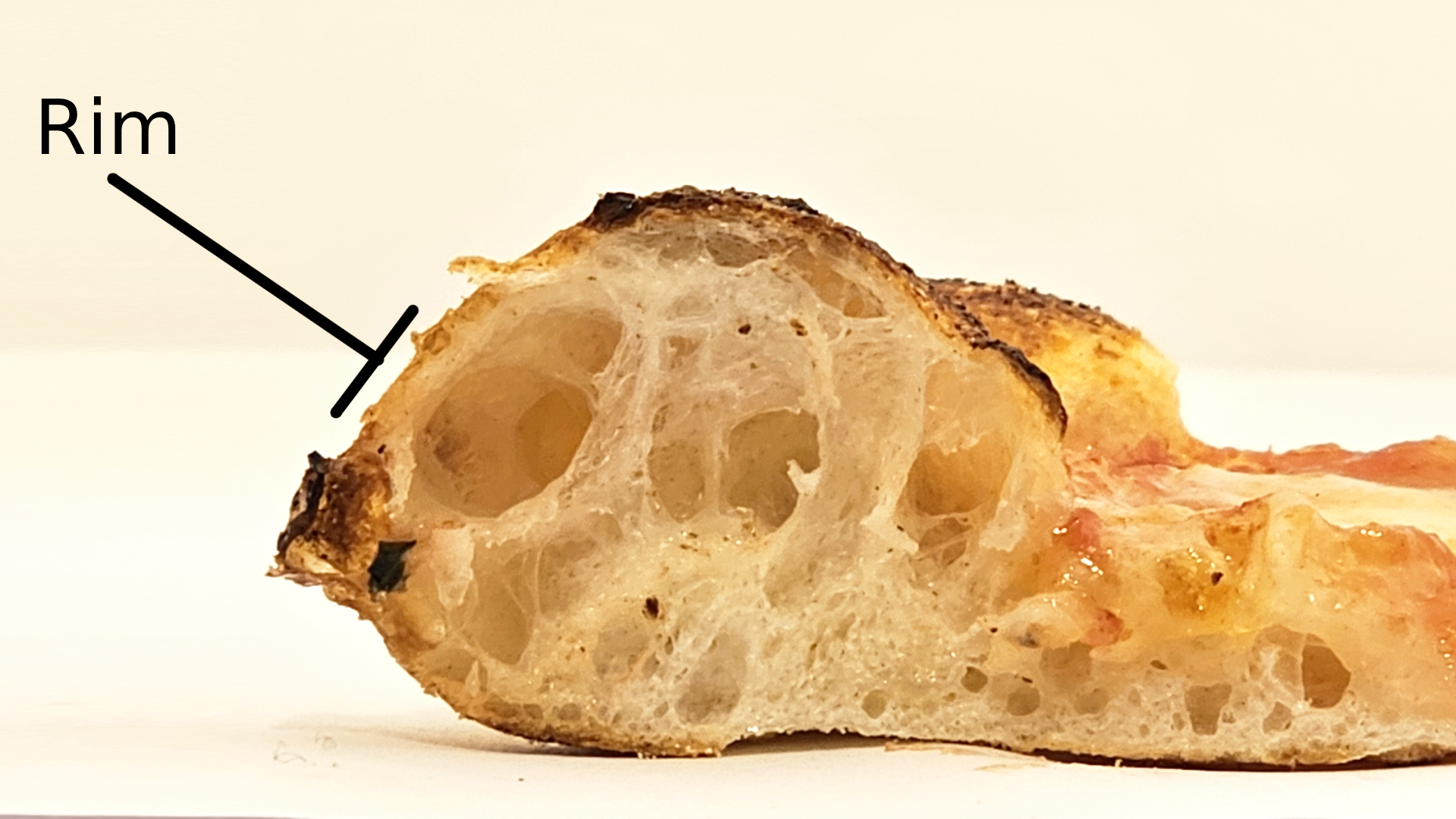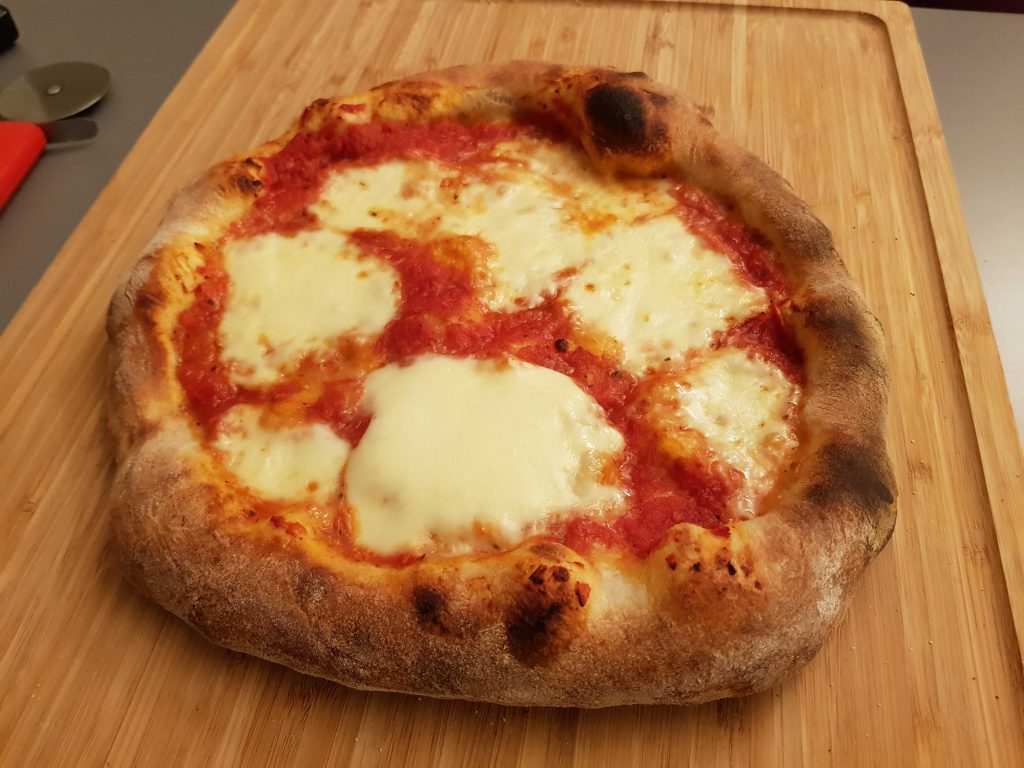If you’re into pizza, you’ve probably heard the word cornicione, and wondered what it means. Does it mean pizza crust in Italian? There’s a lot of confusion out there, due to the different meanings of the word cornicione and crust. This article will tell you everything you need to know in addition to showing you how to make the perfect cornicione.
What Is Pizza Cornicione?
The word cornicione is the Italian word for the edge or rim of the pizza. The cornicione should be an airy, raised edge, that’s crunchy on the outside and light and soft on the inside, typically found on a Neapolitan pizza. In the US, the word crust is often incorrectly used to describe the edge of the pizza. The crust is the whole bread part of the pizza, not only the edge. Especially as a pizza baker, you need more specific terminology, to be able to refer to this important part of the pizza.

True Neopolitan Pizza Cornicione
According to the AVPN’s (The True Neapolitan Pizza Association) international standard for Neapolitan pizza, a true Neapolitan pizza should have a raised edge of 1-2cm (around 1/2-1 inch). The cornicione is also described as an identifying feature of Neapolitan pizza. The cornicione has long traditions in Naples and is a really important part of the pizza.
How to Create the Perfect on Your Pizza
To make the perfect cornicione, you need to start with a good flour, that contains the right amount of gluten, a long, slow fermentation time and to bake the pizza in a hot oven. Let’s take a look at the 4 steps to make cornicione.
1. Gluten Development
Gluten development is the most important part of any pizza dough and is what makes it pliable and stretchy.
What is Gluten?
Gluten is a type of protein found in wheat flour. The most important task of gluten is to keep the dough together. If your dough doesn’t have any gluten, it will simply fall apart. Gluten will give the dough structure and make it elastic and stretchy. A stretchy dough is essential to make Neapolitan pizza and make a great cornicione.
When you hydrate the gluten (soak it in water), and knead it, the gluten will start to grow a strong network of gluten strands. This will give the dough structure. The more you knead the dough, the stronger this network will grow.
Why You Need Gluten to Make Pizza Cornicione
The reason you need gluten is that the gluten network will make small pockets inside the dough. These pockets will trap gas produced by the yeast when you leave the dough to rise. And this will make bubbles inside your cornicione. The edge will puff up nicely, and create a light and soft interior – which is exactly what you’re looking for!
Pizza Flour
Every great pizza starts with great flour. The flour is the single most important ingredient in your pizza dough, because it’s what dictates the gluten development in the dough.
To get proper gluten development you need quality pizza flour, with the right amount of gluten. The best choice is a high-quality Tipo 0 or Tipo 00 pizza flour. These are fine, Italian-milled wheat flours that have a gluten content of around 11-12%.
Tipo 0 and Tipo 00 may vary a lot in quality and gluten content, it’s therefore important to use a type of flour that you know has good quality for pizza making. My personal favorite is Caputo Pizzeria (affiliate link) Caputo is one of the largest flour producers in Naples and one of the approved suppliers by the AVPN.
Caputo Pizzeria is a fairly strong flour that can easily handle a 24-hour rise, and it is therefore perfect for Neapolitan-style pizza. You can read my full review here if you want to know what’s so special about this flour.
How to Develop Gluten
To develop the gluten (make it form this strong network that keeps your dough from tearing), you need to first hydrate the gluten. By combining flour and water, the gluten development process will start. In addition to water, you also have to knead the dough.
If you’re kneading by hand, it will take around 15-20 minutes to knead. If you’re using a stand mixer it will be a bit quicker.
2. Long Fermentation
In addition to gluten development, you need long, slow fermentation, or proofing, to develop those nice air bubbles in the cornicione. A Neapolitan pizza should rise for 8-24 hours. But you can experiment with even longer fermentation times using a method called cold fermentation, which also will add more flavor to your crust.
To achieve a long fermentation time, you need to reduce the amount of yeast. When the dough contains less yeast, the fermentation will slow down and stretch out over a longer period of time.
Once again, I want to emphasize the importance of good flour. If you leave a dough made with all-purpose flour for 24 hours, it will probably overproof. Overprrofing simply means the gluten network is not strong enough to hold on to the gas and will collapse, leaving you with a flat, dense dough without any air bubbles.
3. Shaping and Stretching the Pizza to Create the Cornicione
To preserve the air bubbles created during fermentation, it’s important to keep the edge of the pizza untouched. This is the real secret to a great cornicione! If you press on the edge of the pizza, you will burst the bubbles, and it will not get airy and puff up in the oven.
You should never use a rolling pin, as this will completely ruin the cornicione, because it squeezes all the gas out of the bubbles, leaving you with a dense, crust.
The proper shaping and stretching technique is easier illustrated visually, I have therefore included this great video from Jacob Burton on how to stretch pizza dough:
4. Baking the Pizza in a Hot Oven
Another important factor in creating the perfect cornicione is how you’re baking your pizza. You need to bake the pizza in a really hot oven, to make the cornicione puff up and get nice and crispy on the outside.
It’s challenging to replicate the heat of a wood-fired Neapolitan
Use the Highest Heat Possible
The first thing you should do is to bake the pizza at the highest possible temperature in your home oven. Most home ovens can’t come anywhere near a 900°F (480°C) Neapolitan oven, but you want to get as close as possible.
The high heat is necessary to reduce baking time to get the right crust constancy. Pizza that’s baked at a lower temperature for a longer period of time will get a drier crust. The reason is that more water evaporates during the long bake, leaving you with a very dry crust.
Bake on a Pizza Stone or Pizza Steel
The second thing you can do to improve baking is to use a pizza stone or pizza steel. This will create a hot surface that will bake the bottom of your pizza, and make it nice and crispy. To make sure your baking surface is hot enough, you should let it pre-heat with the oven for at least 45 minutes to 1 hour before you try to bake any pizza.
If you want to know more about how to properly bake pizza on a pizza stone, check out my easy step-by-step guide.
Use the Broiler for Extra Heat
The third and last trick is to use the broiler or grill element of your oven. This will increase the temperature significantly, and you’ll even be able to create the famous leopard pattern you see on the cornicione in Naples! Just keep an eye on your pizza, because it will finish, and potentially burn, pretty quickly.
To fully take advantage of the boiler, you have to place your pizza stone as close as possible. I recommend placing the stone or steel on the top rack of your oven. I also recommend using the broiler to heat the pizza stone, as this will make the stone even hotter.
By combining these three things, you’ll make an amazing cornicione at home!

- Is Your Pizza Dough Too Dry? Here is How to fix it! - June 10, 2024
- The Ultimate Guide to the Pizza Dough Windowpane Test - June 8, 2024
- The Ultimate Guide to Autolyse Pizza Dough - June 7, 2024

Hello, I’m 68 and would like to make some good pizza, which is my grandkids favorite food to eat. They eat over my house (Nana’s), every Sundays. I live in Bakersfield, CA. Where can I buy Capato Pizzeria Flour or the next best thing?
Hello! Great! You can find it on Amazon (though it seems to be out of stock at the moment). If you can’t find Caputo Flour, a good bread flour with similar gluten content (around 12-14% protein) should also do the trick!
Whole Foods carries it in Fresno CA, if you have one in Bakersfield, I would call and see if they carry it. It makes the absolute pizza crust, I have been using it for years. Good luck
You can find Caputo flour on Amazon. Also, in Bakersfield, they sell Pizza flour 00 in Vons/Albertsons store.
Thank you for this information, it is very informative. I have learned a lot on your site.
That was very helpful, thank you. I tried different flours as well as different fermentation methods and different kneading techniques, with different ingredients (dry or fresh yeast and honey or mulberry molasses). Using a home oven, I am still in search of the best way to make a good pizza.